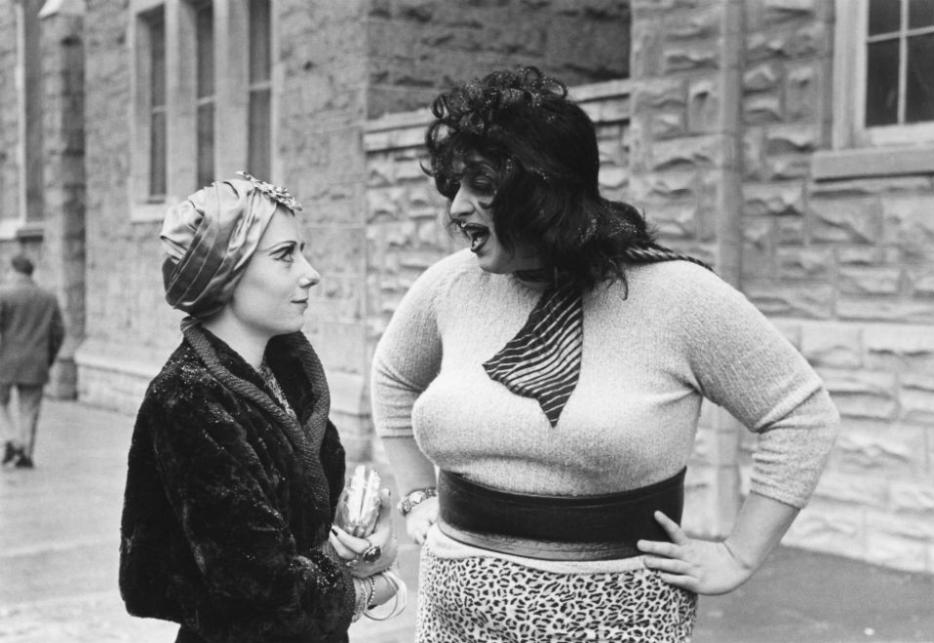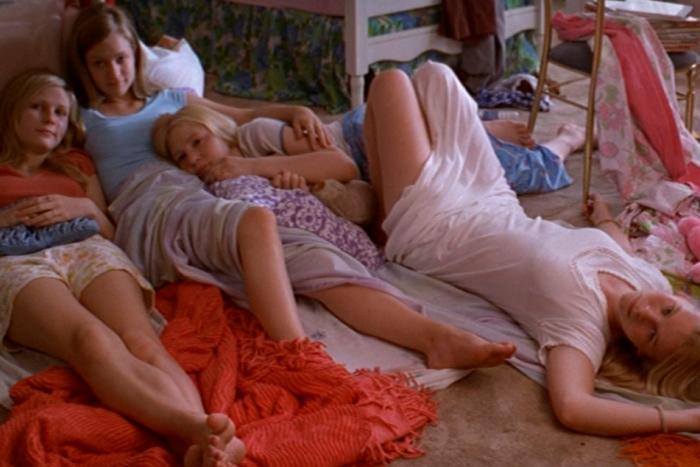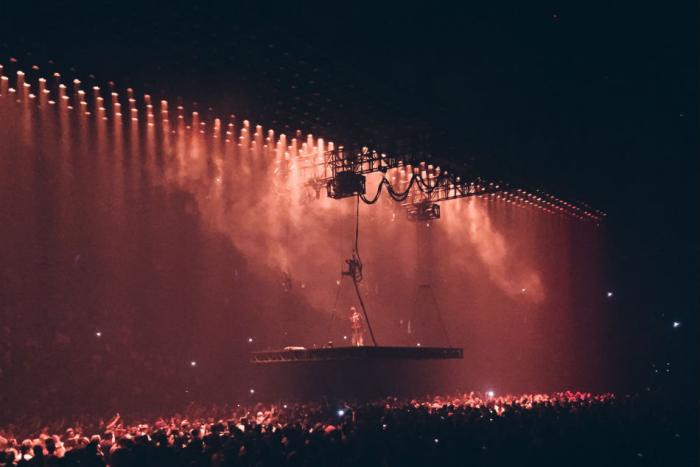“Yes folks, this isn’t any cheap X-rated movie or any fifth–rate porno play! This is the show you want! Lady Divine’s Cavalcade of Perversions, the sleaziest show on earth!” Crowed by a two-tone-haired, ringmaster tails-clad David Lochary, this lurid sales pitch is our introduction to Multiple Maniacs (1970), John Waters’s criminally under-seen and unavailable-for-decades second feature. The Cavalcade, a traveling sideshow that bookends the film’s first act and turns the spotlight on a line-up of puke-eaters, pornographers, and a live OD, is but a brief taste of the maddeningly depraved behavior exhibited in Maniacs, devised by Waters to simultaneously skewer the so-called “straight” values of the American middle class and the post-Charlie Manson peace-and-love ethos of his flower children peers.
Waters is now our most adored public intellectual who wears the hell out of a Comme des Garçons suit, but in the late ‘60s, the Baltimore native was corralling his troupe of Dreamlanders (actors Lochary, Mary Vivian Pearce, Cookie Mueller, Mink Stole, Edith Massey, and Divine) to create a new kind of high camp, high satire art cinema seated in the provocations of deranged comedy and exploitation films. Maniacs’s twisty, turn-y plot cedes coherence to melodrama. It’s a whirlwind, as our tour de force heroine, Lady Divine, exposes the affair of her lover (Lochary), starts a new romance in church after a buttoned-up woman (Mink Stole) seduces her with a (yes) rosary-in-the-bum sex act, and goes on a noirish bender of revenge, murder, and cannibalism before she falls victim to the Lobstora, an acid dream of a B-movie monster. Ever a survivor, Divine goes on one last rampage (carjacking, window smashing) before she’s put out of commission by the National Guard.
Filmed on a dime in his parents’ front yard and in his own apartment, Maniacs spent the last thirty or so years in limbo in Waters’s attic before Janus Films completed a full restoration. Its offenses (a Baltimore judge ruled the film “obnoxious but not legally obscene”) are many, but this “monster movie,” as Waters describes it, is a prescient example of the themes that would go on to dominate his body of work. Grotesque, macabre, and unnervingly funny, it’s peak Waters. I recently spoke with the director by phone.
Colleen Kelsey: You’ve cheekily mentioned that this restoration looks like a bad Cassavetes movie. As the credits say, Multiple Maniacs is “Produced, Directed, Written, Filmed, and Edited by John Waters.” This was made completely guerilla style.
John Waters: Well, it was just a matter of necessity. I didn’t have a production designer. Vince Peranio was the production designer for that movie, and he did every one of my other movies and The Wire. But the first thing he ever did for us was Lobstora. He’s in Lobstora, with his brother Eddie. You can see their legs in it. But there was no other production designer. I just rented those tents. David Lochary kind of designed the costumes, I think. And we had this old Jewish lady who made clothes for drag queens in her basement without her husband knowing. She was real old-fashioned, and she’d say, “Come to the basement, I don’t want him to see you.” Divine would get all his drag made there, but so did a lot of drag queens. She had a secret drag queen clientele in her basement, and she made those clothes, and I think David Lochary probably sketched them. This was the first movie before Van Smith came aboard. He did all the clothes and makeup and costumes since.
We never had a permit. There was no such thing as a film commission then. I didn’t have a location manager. I never even heard that expression. But we were just guerilla filmmaking, we’d just jump out and do it, kind of like in Cecil B. Demented [2000]. But the scene at the end, that was early Sunday morning, and you can see the crowd running around the corner, just people basically just coming out of their house and joining in. There was no continuity, you can see the same people when they come around the corner. But we were nervous, because in Mondo Trasho [1969] we had been arrested for “a conspiracy to commit indecent exposure,” which got national attention. I was on my parent’s lawn, but I knew we wouldn’t get arrested there. A lot of that outside was out in Lutherville, Maryland, and nobody was gonna arrest us there. Pete’s Bar, where Edith worked, that’s where she really worked.
Vincent Peranio and Susan Lowe both moved to Fells Point, which at the time was the cheapest, worst slum neighborhood. Now it’s total hipsters and everything, but at the time it was the poorest neighborhood you could live in in Baltimore. She worked at Pete’s Hotel, which was kind of a wino bar. They went in there, drinks were 30 cents, I remember, and they were like, “You’ve got to meet this barmaid.” We went in, and it was Edie. So we all started hanging out there, except Divine. Divine always hated it there.
Was the film completely scripted?
It was long pages of dialogue they had to memorize, but the script wasn’t written completely before. I think probably “The Cavalcade” was. We just shot, which was usually on weekends. It took all fall and winter, but it might’ve been eight days before we could kind of get it together. The script was handwritten, I remember. At Wesleyan University there’s some copies of it. Mink Stole helped, some was in her handwriting, we just had to make copies. I don’t even think it’s typed. But, yes, we had rehearsals, always in my apartment. Even though a lot of people did take drugs, nobody did when we were working. I mean, it was really long, killer days. I don’t know how I ever made it, if you think about it. The whole movie cost $5,000, which today I guess would be $25,000. I remember where I edited it up in my attic. That house is still there. It looks the same from the outside. But Mink was just here this weekend, we just celebrated fifty years since we first met in Provincetown. Every person that’s in that movie that’s alive, I know where they are. Except for the puke-eater. I’m sure he’s alive and well, I hope. Maybe this will bring him out. [laughs]
You excoriate two societal opposites equally: middle-class values and the reactive counterculture of the era.
I was trying to make an exploitation homage that would play in art theaters. I was coming from an underground movement, and it was really before there were independent movies, so it was a time when every censorship law was crumbling because of art movies, really. Then I was going to the drive-in every night and seeing exploitation movies. I was trying to put those two genres together, and I think I stuck to that my whole life. A Dirty Shame [2004] was a sexploitation movie made for art theaters.
I was making fun of hippies, just like today you’d make fun of political correctness. Even though I was, I guess, technically a hippie, and I think I’m politically correct today. But I always try to test those limits, with gay correctness too. How far can you go and be funny, and at the same time, ask questions that people don’t usually like to bring up?
In the movie, “straight people” didn’t mean heterosexual. Straight people meant people that didn’t smoke pot. Of course the straight people in this movie were Cookie Mueller and Mary Vivian Pearce, everybody in wigs and disguises, the same cast. This was a monster movie, in a way, a completely normal monster movie, where the National Guard kills the monster in the end. But in Godzilla [1958] and Gorgo [1961], they liked being the monster. They’re happy being a monster. I think Divine was happy being insane. She had to go over the edge to really become “Divine” and be this insane person. Then it gets surreal and she gets raped by a lobster. That kind of stuff, I don’t know, we took a lot of acid then. It didn’t seem like such a stretch in the plot point. Although now I look at it, and that’s what makes it funny. “Huh, where did that come from?” [laughs] Imagine if an audience had to fill out comment cards on a focus group for that movie.
In contrast to the exploitation movie model, the Passion interlude—when Divine is getting the “rosary job”—that sequence, to me, veered into European surrealism. It was almost a companion piece to the Last Supper scene in Buñuel’s Viridiana [1961].
You’re right about Viridiana, which was a movie that I completely loved. Viridiana was a huge influence, certainly, and [Pasolini’s] The Gospel According to St. Matthew [1964]. Kenneth Anger had religious stuff in Scorpio Rising [1963]. And the surrealists certainly used lobsters, so that was in there. It was a lot of different influences. But at the same time, I grew up Catholic. Probably the only enemy I have left is the Catholic Church. The sexual rosary job, believe me, I made that up. I’ve never heard of someone giving one. But Mink used to dress like that. Mink was kind of goth. She had black nail polish and used to wear rosaries. We always used to wear rosaries around our neck when we were hippies, which, I don’t know why. I used to have bubblegum rings that had Jesus and Mary on it and stuff. All that Catholic imagery that we were raised on, we were rebelling from still, obviously, and used it in a sexual way. It was a religion that was so against sex that it was easy to sexualize it.
There are many different genres built into the film narrative, not just the monster angle, but David and Mary Vivian Pearce’s storyline drums up a melodramatic, doomed affair picture.
There was I, a Woman [1965], which was a big hit then. Mary Vivian Pearce, when she’s lying there, was in the exact same position as Essy Persson was in the famous poster and ad for I, a Woman. I think that movie was the big influence. It was the biggest sexploitation movie of the time then. It played for like a year in different cinemas. It was [erotic film distributor] Radley Metzger. Even though I, a Woman was not very sexual to me, I just remember the ad campaign so much.
She’s such a dead ringer for Jean Harlow, too.
That was what Mary Vivian Pearce looked like every day then. She wore bright red lipstick. Nobody did. She hitchhiked from New Orleans to my apartment in San Francisco alone dressed like that and nothing happened.
Does the film play differently now versus the initial release?
Then, it was bikers, and crazy drunken rednecks, and lunatic gay people, and all kinds. But it was an audience that’s the same audience I have today, just a different generation of them. They were always people that laughed at authority, that were angry but had a sense of humor. They realized the absurdity of everything, of both cultures. The culture that they were rebelling from, and the culture that they were in, now, that had rules too. Those were the rules that I always made fun of.
This summer it was in the Provincetown Film Festival, and I saw it with a sold out audience, and it played great. But people were startled by it. Maybe it plays better today, I don’t know. We’ll see. It’s opening in 20 cities. It’s kind of amazing to me. It’s just really satisfying and exciting to see Janus Films. When I would go downtown and see Never on Sunday [1960] and art movies that were condemned by the Catholic church, and drink espresso coffee in the art theaters, which is what they had at the time to make you feel adult and foreign, it was always Janus Films. It would be almost impossible to have imagined that then in 1970.






